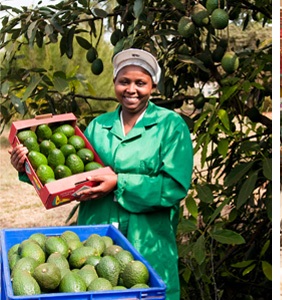
Farmer displays hass avocado harvest. Pest control eases penetration into the triple paying EU market. Photo by Courtesy.
With the expanding of the export market into the European Union after the introduction of the controlled atmosphere shipping equipment, farmers can beat chemical residue hurdle using organic methods of pest control.
The EU market recently froze the chemical residue level from 0.2 to 0.02 parts per a million for agro-products entering member states.
Although it can be tedious to do than the knock down chemicals, the market pays more than three times more for the avocado compared to what the farmers earn in Kenya.
Agronomist Wycliffe Obwoge says the option of using chemicals is a ‘knock-down’ last resort that lowers the penetration into more lucrative markets.
One of the common pests is the false codling moth larva that drills into the fruit flesh before reaching the core. Under heavy infestation, the larvae can cause up to 90 per cent losses.
Bagging the individual fruit is the most effective way of controlling the pest although tedious and time consuming, the agronomist said.
Bagging stops pests like the false cold month from laying eggs on the maturing fruits.
“Protecting these fruits against pests is the start of recovering the investment and making profits. Now that more companies are exporting the fruit to the EU instead of the rational Middle East markets, limiting the chemical use is the key,” he said.
Common avocado varieties like has and fuerte are short and, therefore, reachable from ground standing heights or stepping on stools.
Affected fruits have to be buried in holes of more than two feet or enclosed on polythene bags to and placed under direct sunlight to die.
READ ALSO: Manual oil extractor to save avocado farmers from losses
READ ALSO: Controlled containers boost Kenyan avocado export market
READ ALDO:Europe avocado demand to benefit Kenyans until August
An avocado of about 500g costs between Sh20 and Sh30 in Nairobi.
But when the brokers who bring the fruit to the city buy from farmers, they do so at price less than Sh5.
Avocado harvesting season starts in March and runs until September. Whilst hass matures from May, fuerte is ready for harvesting from March.
More than 115 metric tonnes of avocados are produced each year, with small-holder farmers accounting for about 70 per cent.
In 2016, shipping companies introduced CA equipment that extend the shelf-life of the avocados from seven five days to about six weeks.
With this development, shipping avocado from Mombasa to EU, which was limited, was made possible because the fruit arrives in the market while in good shape and still raw. Extracts from neem tree are also important noncommercial chemical effectively controlling the cold month and other pests.
The cold moth is an important pest that also attacks more than 14 fruit varieties.